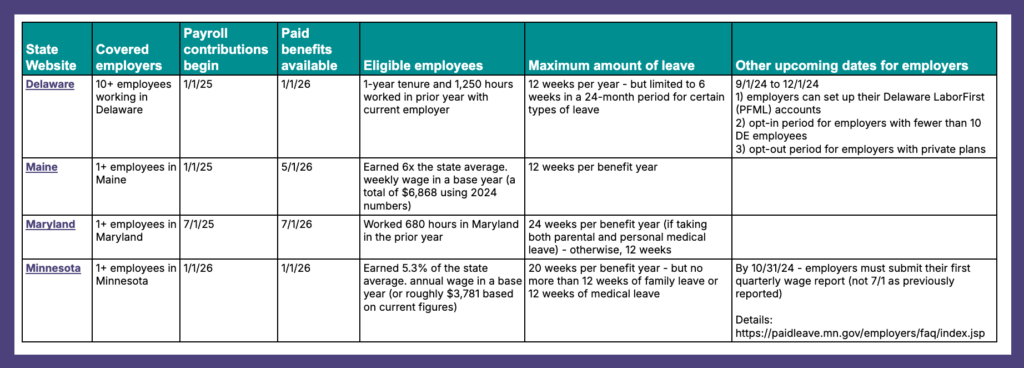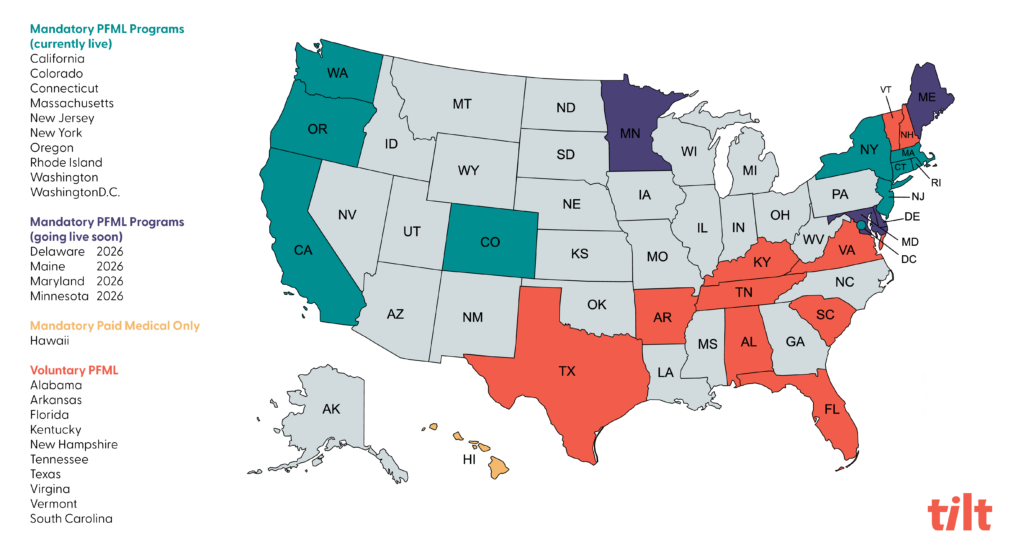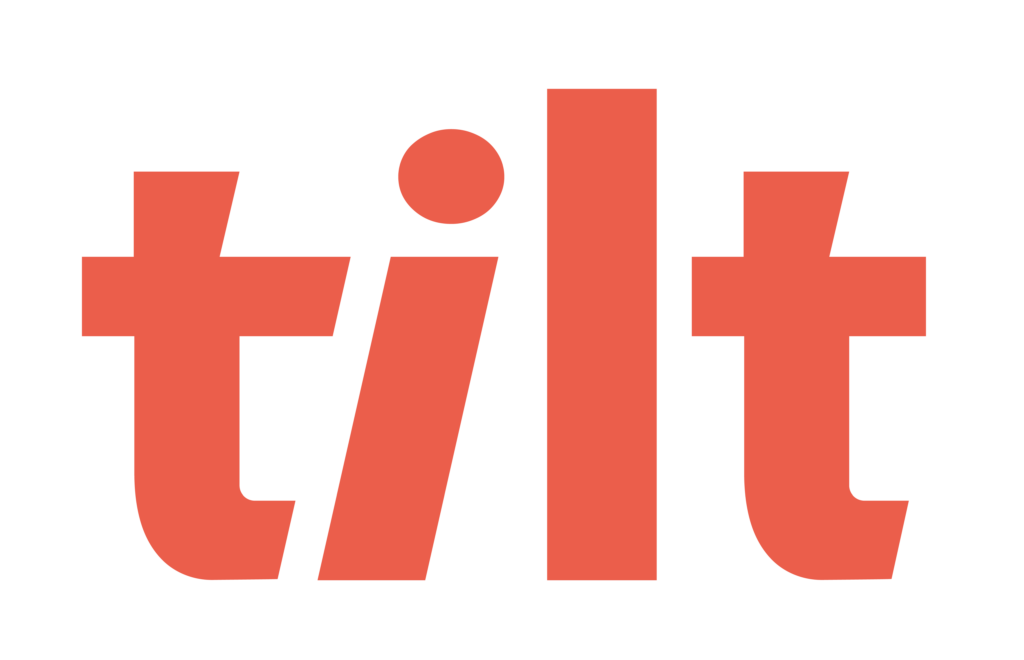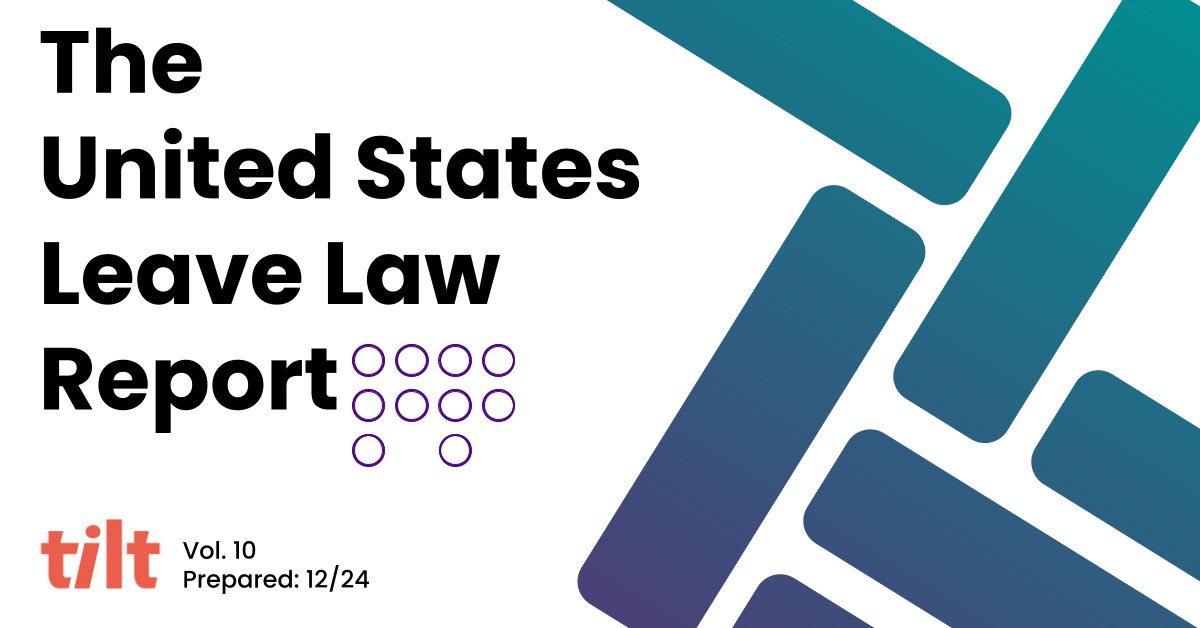As the year marches onward, we remain dedicated to keeping you updated and well-prepared with the latest in leave law developments. It’s critically important to stay current with these changes as you navigate the dynamic landscape of People Operations, so we’re here to make that navigation a little easier for you.
Our team of leave law experts at Tilt is committed to continuously monitoring the progress and changes in leave laws throughout the year. Our mission is to ensure you are fully informed and ready to adapt to any modifications that might impact your organization.
This report offers the latest updates on leave programs across the country, providing insights into how these changes could affect you and your team. We believe that staying informed is a necessity for effectively supporting your employees and ensuring compliance with relevant regulations.
We hope the information in this report proves valuable in this aim.
Thank you for continuing to trust Tilt as your partner in efficiently and compliantly managing leave programs. If you have any questions or need further assistance, please don’t hesitate to reach out.
Looking for insights from previous volumes? See what you might have missed here.
Federal Legislation: Paid Family & Medical Leave (PFML)
TL;DR: November’s elections may determine trajectory of national PFML
Vice President Kamala Harris has kicked off her 2024 presidential campaign with promises to fight for a national paid family and medical leave (PFML) program.
However, a divided Congress is unlikely to enact a robust national PFML program. So, unless Harris wins the presidency and Democrats gain control of both chambers of Congress, existing bipartisan Congressional working groups will likely shape the path forward.
As previously reported, these working groups have been meeting over the past 18 months to explore PFML options and draft legislation that could survive a bipartisan vote.
The groups have signaled that their proposal will likely foster the growth of state PFML programs, instead of guaranteeing national coverage. If adopted, this approach would expand employee access to leave–at least in certain states–but at a cost of increased complexity for employers.
State PFML Programs - Overview
TL;DR: Four state PFML programs start paying in 2026; more voluntary PFML laws pass
State PFML programs can be either mandatory or voluntary. Mandatory programs typically function as “social insurance,” with funding through payroll deductions and paid benefits guaranteed to eligible employees who need leave for a qualifying reason. In contrast, voluntary programs permit, but do not require, employers or employees to purchase PFML insurance as a private market product–and they cover fewer workers as a result.
Mandatory program updates:
The mandatory PFML landscape has remained unchanged since July 2023, when Maine became the thirteenth state (in addition to Washington D.C.) to enact a mandatory PFML law. Mandatory PFML benefits are currently available to eligible employees in California, Colorado, Connecticut, Massachusetts, New Jersey, New York, Oregon, Rhode Island, Washington and Washington D.C.
Mandatory PFML benefits will become available to employees in Delaware, Maine, Maryland and Minnesota in 2026, and the key details of these programs are displayed below. Please note that the information is subject to change as these states continue to work through their rulemaking processes.

Voluntary program updates:
Republican-controlled states have been active in passing voluntary PFML laws. Most recently, on May 21, 2024, South Carolina became the tenth state to take a voluntary PFML approach, joining Alabama, Arkansas, Florida, New Hampshire, Kentucky, Tennessee, Texas, Virginia and Vermont.

State Leave Law Updates
California: Direct deposit available
California’s Employment Development Department (EDD) recently upgraded the employee benefit payment options for its state-paid benefit programs (such as State Disability Insurance and Paid Family Leave) to include direct deposit.
Colorado: Lower PFML demand than anticipated
Colorado started paying benefits under its Family and Medical Leave Insurance (FAMLI) program in January 2024. In the program’s first six months, more than 62,000 Colorado workers received $311 million in benefits, 44% less than projected. Colorado plans to continue outreach and education efforts to help ensure eligible employees know about the benefits available to them.
Connecticut: Expanded PFML coverage and paid sick leave requirements
Beginning October 1, 2024, Connecticut Paid Leave (CTPL) benefits will extend to victims of sexual assault for purposes of seeking care or participating in the criminal justice process.
CTPL benefits are currently available for eligible employees who need leave for certain bonding, family caregiving, medical, military family and family violence reasons.
In addition, Connecticut recently amended its paid sick leave law to apply to more employers and employees.
The law currently applies to employers with 50 or more “service workers” in Connecticut, but the amendments remove the “service worker” requirement, and the law will apply to any employer with:
- 25 or more employees in Connecticut as of January 1, 2025
- 11 or more employees in Connecticut as of January 1, 2026
- One or more employees in Connecticut as of January 1, 2027
The amendments also modify provisions covering permitted leave reasons, sick time accrual, employee eligibility, notice requirements, supporting documentation and records retention.
Connecticut employers are encouraged to consult with counsel to review their existing sick time policies and make any necessary changes before the January 1, 2025 effective date.
New York: Paid time off for prenatal appointments and lactation breaks
As of June 19, 2024, employers must provide paid breaks to employees in New York as often as reasonably needed to express breast milk for a nursing child, for up to 30 minutes each break.
Also, New York employers must provide the New York State Department of Labor’s model policy to employees upon hire, on an annual basis and whenever an employee is returning to work following the birth of a child. (Tilt assists customers by including the lactation notice in its communications to NY employees returning from a birthing leave.)
As previously reported, employers must provide up to twenty hours of paid time off (PTO) to pregnant New York employees for prenatal appointments and procedures beginning January 1, 2025. Pregnant employees can use the twenty hours of PTO for “physical examinations, medical procedures, monitoring and testing, and discussions with a health care provider related to the pregnancy.”
The twenty hours of prenatal PTO is in addition to the bank of time required under New York’s paid sick leave law, and the PTO can be taken in hourly increments. Employers with New York employees should ensure their time off policies and systems are updated for 2025 to reflect this new bank of available PTO.
Oregon: Leave law changes went live on 7/1 (prev. reported)
The previously reported changes to Oregon leave laws went into effect on July 1st, which means that Oregon Family Leave Act (OFLA)’s unpaid job protection now applies in fewer leave situations: pregnancy disability, caring for a sick child, caring for a child with a serious health condition, bereavement, and certain military-family or adoption-related reasons.
Although OFLA has been scaled back, Paid Leave Oregon (PLO) remains available for most Oregon employees who need leave for family and medical reasons. PLO and OFLA can no longer run concurrently, so when an eligible employee needs leave for a reason that could be covered under either law (such as pregnancy disability), the employee can choose OFLA protection or apply for PLO for any given leave segment.
Rhode Island: TCI benefits increased
Rhode Island’s Temporary Caregiver Insurance (TCI) program provides eligible employees with up to six weeks of paid leave for family caregiving and new child bonding reasons.
On June 13, 2024, the state legislature passed a law to increase the maximum benefit duration to seven weeks beginning January 1, 2025, and eight weeks beginning January 1, 2026. In addition, the legislation doubled the minimum weekly allowance for dependents: from $10 to $20 per dependent, for up to five dependents.
Washington: Concerns about high PFML utilization (updated)
Last fall, we reported Washington State’s concerns about the high utilization of its WA PFML program, which paid out $1.5 billion last year–24% more than the previous year.
Washington’s Employment Security Department is now reporting that the WA PFML program could run a deficit as soon as this October, and it may be more severe than initially projected. As a result, employee contribution rates are likely to increase soon.
Thank you for your interest in learning more about the latest leave laws impacting states across the country! At Tilt, we live and breathe all things leave and are passionate about supporting and educating everyone on the importance of empathetic and compassionate leaves of absence. If you have any questions about the latest leave laws or about how to better support your people when they need a leave…drop us a line.
About Tilt
Tilt is leading the charge in all things leave of absence management through easy-to-use tech and human touch. Since 2017, our proprietary platform and Empathy Warriors have been helping customers make leave not suck by eliminating administrative burdens, keeping companies compliant, and providing a truly positive and supportive leave of absence experience for their people.







